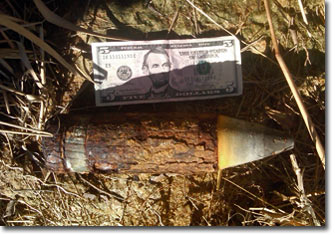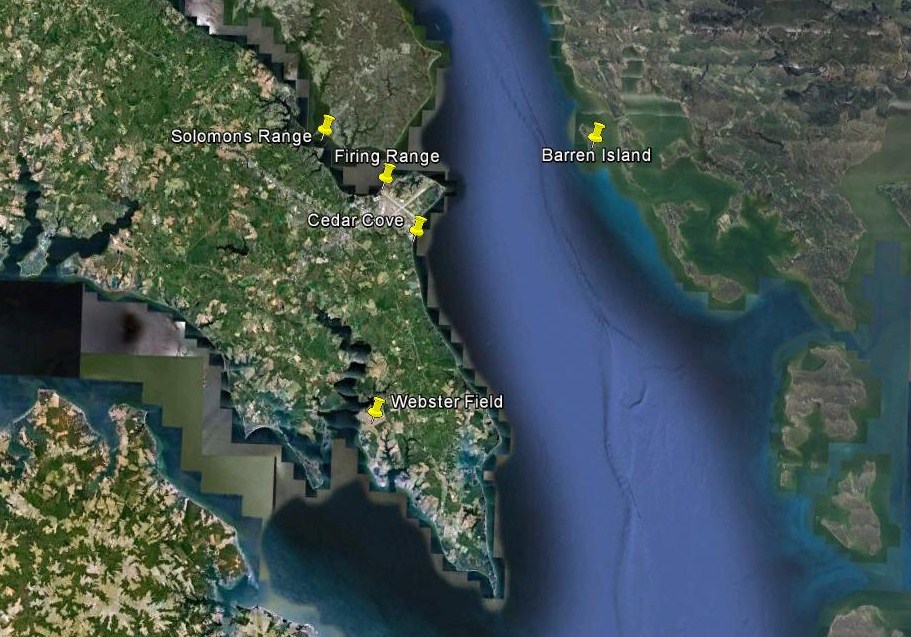The Other Lost Munitions

By Jay Friess
Editor

This Maryland Department of Natural Resources photo shows one of the shells recovered at Newtowne Neck State Park.
When opening Wednesday night’s hearing on the Navy’s ongoing efforts to recover lost ordnance buried about Southern Maryland, Steve Hurff warned the audience that none of his presentation would cover recent events at Newtowne Neck State Park.
Hurff, munitions response team lead for Naval Facilities Washington (NAVFAC), said that the Navy has not taken the lead on recovering the more than dozen pieces of old ammunition that have been discovered at the site near Leonardtown since the beginning of the year. According to St. Mary’s County government, the Maryland State Fire Marshal’s Office Bomb Squad, Maryland Park Service, and U.S. Army Corps of Engineers are handling the recovery as the park remains closed to the public.
Instead, Hurff is concerned with efforts to recover munitions dumped, dropped, fired or lost on federal lands in Southern Maryland and the surrounding waters. The Navy has grouped these sites into five different focuses – three at Naval Air Station Patuxent River, one at Webster Field and one in the waters off Navy Recreation Center Solomons.
Of the three sites at Pax River, the one that has drawn the most attention is the old beachfront ammo dump on the south end of the base, near the Spyglass apartment complex. From 1954 to 1974, it was the base’s policy to dump unused or old munitions into the water off the shore. The Navy stopped this practice after Congress passed the Clean Water Act, but not before disposing of an estimated 30,000 pounds of explosive material.
“There were no standards of where you could dump hazardous waste,” said Capt. Ted Mills, Pax River commander.
Navy recovery teams have found everything from small arms rounds to 1,000-pound bombs at the site. A recent metal detector sweep of the waterbed in the area found 370 items still embedded in the silt. However, not all is as it seems. A pile of metal identified by the sweep last year was thought to be a cache of old 2.5-inch rockets. When a storm uncovered the mass, it turned out to be fence posts, Hurff said.
“There haven’t been any ordnance found since the 1990s,” Mills said, adding that the Navy continues to scan the site periodically.
Hurff’s munitions response team is also investigating the old skeet and small arms firing range on the north end of Pax River at the mouth of the Patuxent. The area was used for weapons practice from the 1940s to the 1980s. And the team is investigating sites the base used at Kent, Sharps and Barren Islands in the Chesapeake Bay to test torpedoes and mines. At these sites, Hurff said the team has found a wide range of explosives used for testing.
“It’s anything,” Hurff said.
The same goes for the deep waters off Solomons Island, where similar testing was done between the 1940s and the 1970s.
The site at Webster Field is less varied. The site was primarily used to test inert munitions between 1943 and 1951, although Hurff noted that the Navy did find one unexploded bomb.
Part of Hurff’s team’s job is to prioritize the sites for cleanup. Using a complicated scoring process, the team give the sites a score of “1” (being the most critical) to “10” (being the least critical). The Pax River Cedar Cove site ranks a “3.” The Chesapeake island sites and the waters off Solomons rate a “4.” The St. Inigoes site rates a “5.” While the old Pax River firing range rates an “8.”
The team will be wrapping up its preliminary assessment process by the end of January and is scheduled to complete its site investigations by 2012. More intense remedial investigations are scheduled from 2013 to 2019, and the Navy hopes to wrap up the sites by 2019.
For more information on the site remediation process, comment on the process or furnish information to the Navy on the sites, contact Gary Younger, Pax River’s public information officer, at [email protected].
























